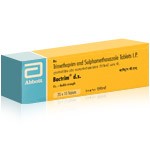Ear Infections in Toddlers


Otitis media, or middle ear infection, is one of the most common illnesses in toddlers, second only to upper respiratory infections like the common cold. Because of anatomical and immunological factors, children between six months and three years old are particularly vulnerable. While most cases resolve without long-term effects, untreated or recurrent otitis media can lead to hearing problems, speech delays, and more serious complications. This article explores the causes, symptoms, stages, treatment strategies, red flag warning signs, and the role of antibiotics such as Bactrim in managing the condition.
What Is Otitis Media?
Otitis media is defined as inflammation or infection of the middle ear, the air-filled space behind the eardrum that contains the ossicles responsible for transmitting sound. In toddlers, this infection usually arises after a viral upper respiratory tract infection, when the Eustachian tube — the canal that connects the middle ear to the back of the throat — becomes swollen or blocked. The blockage traps fluid in the middle ear, creating an environment where bacteria or viruses can multiply.
Because children’s Eustachian tubes are shorter, more horizontal, and narrower than those of adults, fluid drainage is less efficient, increasing the likelihood of infection.
How Do I Know If My Child Has Otitis Media?
Recognizing otitis media in toddlers can be challenging because they often cannot describe ear pain or pressure. Instead, parents must look for behavioral cues and physical signs. Common symptoms include:
- Ear pain: The child may tug, pull, or scratch at one or both ears.
- Irritability and fussiness: The discomfort can be significant, especially at night when lying down increases pressure in the ear.
- Sleep disturbances: Pain may make it difficult for toddlers to settle or stay asleep.
- Hearing difficulties: Temporary hearing loss may occur because of fluid accumulation. Parents may notice that the child does not respond as readily to sounds or speaks less clearly.
- Fever: Many toddlers develop a mild to moderate fever, often above 38°C (100.4°F).
- Fluid drainage: In some cases, pus-like or clear fluid may leak from the ear if the eardrum ruptures.
Because these symptoms overlap with other childhood illnesses, it is important for a pediatrician to confirm the diagnosis using an otoscope to inspect the ear canal and eardrum.
What Are the Red Flag Symptoms of Otitis Media?
While most cases are mild and self-limiting, certain symptoms suggest complications or severe infection that require urgent medical attention. Parents should seek medical care promptly if their toddler experiences:
- High fever (above 39°C / 102.2°F).
- Severe ear pain not relieved by acetaminophen or ibuprofen.
- Persistent vomiting or lethargy.
- Swelling or redness behind the ear, which may indicate mastoiditis, a serious infection of the bone behind the ear.
- Neck stiffness, severe headache, or sensitivity to light, which could point to meningitis, a rare but life-threatening complication.
- Frequent recurrent infections (three or more in six months or four in one year).
- Developmental delays in speech or hearing, suggesting fluid buildup is interfering with auditory function.
Recognizing these warning signs early ensures that appropriate treatment is started promptly and that long-term damage to the ear is avoided.
The Five Stages of Acute Otitis Media
Medical researchers often describe the natural progression of acute otitis media in five stages. Understanding these stages helps parents and healthcare providers recognize how the disease develops:
- Eustachian Tube Dysfunction The process begins when a cold, allergies, or adenoid enlargement causes swelling of the Eustachian tube. Negative pressure develops in the middle ear, leading to fluid accumulation.
- Hyperemia and Inflammation The eardrum becomes red, thickened, and immobile due to the inflammatory response. At this point, the toddler may start to experience pain and irritability.
- Suppuration Bacteria invade the trapped fluid, leading to pus formation. Pressure builds behind the eardrum, causing severe pain and sometimes bulging of the tympanic membrane. Fever is common.
- Perforation In some cases, the eardrum ruptures spontaneously, releasing pus into the ear canal. Although the rupture can be alarming for parents, it usually relieves pressure and pain.
- Resolution or Complication With treatment or the body’s immune response, inflammation subsides and healing begins. If untreated, however, complications like chronic otitis media, mastoiditis, or hearing impairment may develop.
How Do You Treat Otitis Media in Toddlers?
Treatment depends on the severity, duration of symptoms, and the age of the child. Pediatricians consider several approaches:
Observation (“Watchful Waiting”)
For children over two years old with mild symptoms and no red flag signs, observation for 48–72 hours is often appropriate. Many cases of otitis media resolve spontaneously as the child’s immune system clears the infection. Pain management with acetaminophen or ibuprofen, adequate hydration, and rest are the mainstays during this period.
Antibiotic Therapy
If symptoms persist beyond 48 hours, if the child is younger than two, or if the infection is severe, antibiotics are typically prescribed. Amoxicillin is the first-line choice due to its effectiveness against Streptococcus pneumoniae and Haemophilus influenzae. In cases of allergy or resistance, alternatives like cefdinir, azithromycin, or trimethoprim-sulfamethoxazole (Bactrim) may be used.
Pain Management
Relieving discomfort is essential. In addition to oral pain relievers, warm compresses can help soothe the affected ear. Decongestants and antihistamines are generally not recommended for toddlers.
Tympanostomy Tubes
For children with recurrent otitis media or persistent fluid behind the eardrum (otitis media with effusion) that interferes with hearing, a minor surgical procedure may be recommended. Tiny ventilation tubes are inserted into the eardrum to allow fluid drainage and equalize pressure.
The Role of Bactrim in Treating Otitis Media
Bactrim, a combination of trimethoprim and sulfamethoxazole, is an antibiotic that works by inhibiting bacterial folate synthesis, effectively stopping bacterial growth. While it is not the first-line therapy for otitis media, it has historically been used in certain cases.
When Bactrim Is Considered
- Penicillin allergy: Children who cannot tolerate amoxicillin or related drugs may be given Bactrim as an alternative.
- Resistant bacteria: In some regions where resistance to amoxicillin is high, Bactrim may provide coverage against susceptible strains of H. influenzae and Moraxella catarrhalis.
- Recurrent infections: Pediatricians may consider Bactrim in complex or recurrent cases when other antibiotics fail.
Limitations
However, Bactrim is not universally effective. Over time, bacterial resistance to trimethoprim-sulfamethoxazole has increased, especially among S. pneumoniae. This has reduced its role in frontline treatment. Moreover, Bactrim can cause side effects such as skin rash, gastrointestinal upset, or, rarely, more severe reactions like Stevens–Johnson syndrome.
Clinical Perspective
Thus, while Bactrim remains an option, its use is typically reserved for specific scenarios and only under pediatric guidance. Parents should never administer antibiotics without a doctor’s prescription, as inappropriate use contributes to resistance and potential harm.
Prevention of Otitis Media in Toddlers
Reducing risk factors plays a vital role in lowering recurrence rates:
- Breastfeeding: Infants who are breastfed for at least six months have lower rates of otitis media due to maternal antibodies.
- Avoiding secondhand smoke: Smoke exposure impairs Eustachian tube function.
- Vaccinations: Pneumococcal and influenza vaccines decrease the incidence of ear infections.
- Proper feeding position: Avoid bottle-feeding while the child is lying flat, as this can allow fluid to flow into the middle ear.
- Managing allergies and nasal congestion: Controlling chronic congestion can reduce ear infections.
Long-Term Outlook
Most toddlers recover from otitis media without complications. With proper treatment, hearing usually returns to normal within days to weeks. However, untreated or recurrent infections can impair language development. This makes parental vigilance, early recognition, and timely pediatric evaluation essential.
Conclusion
Otitis media in toddlers is a common but potentially distressing condition that can significantly affect a child’s comfort, sleep, and development. Parents should be alert to symptoms such as ear tugging, irritability, fever, or fluid drainage. Red flag signs like severe pain, high fever, swelling behind the ear, or neurological symptoms demand urgent medical care. Understanding the five stages of acute otitis media helps explain the disease’s progression and highlights the importance of early intervention.
Treatment strategies range from watchful waiting and pain relief to antibiotics and, in some cases, surgical intervention. While amoxicillin remains the first-line therapy, Bactrim may still play a role in certain circumstances, particularly for children with allergies or resistant infections. Preventive measures, including breastfeeding, vaccinations, and reducing smoke exposure, further reduce risk.
With prompt recognition and appropriate treatment, most toddlers recover fully from otitis media, allowing them to continue developing speech, hearing, and social skills without interruption.
Drug Description Sources: U.S. National Library of Medicine, Drugs.com, WebMD, Mayo Clinic, RxList.
Reviewed and Referenced By:
Dr. Richard M. Rosenfeld, MD Pediatric otolaryngologist and global expert on otitis media. Former President of the American Society of Pediatric Otolaryngology, he has authored clinical guidelines on ear tube use and middle ear infection management.
Dr. Lauren O. Bakaletz, PhD Professor of Pediatrics and Otolaryngology at Ohio State University. Her research focuses on the role of Haemophilus influenzae and Moraxella catarrhalis in recurrent otitis media, advancing understanding of microbial pathogenesis.
Dr. Janet Gilsdorf, MD, PhD Pediatric infectious diseases specialist at the University of Michigan. She is widely recognized for her studies on Haemophilus influenzae and its epidemiology in childhood ear infections.
Dr. Garth D. Ehrlich, PhD Researcher at Drexel University specializing in microbiology and genomics. He pioneered the concept of bacterial biofilms in chronic otitis media, reshaping treatment strategies.
Dr. Michael E. Pichichero, MD Clinical professor of pediatrics and infectious disease researcher. His work emphasizes antibiotic therapy, diagnostic accuracy, and prevention strategies for recurrent otitis media in children.
(Updated at Aug 26 / 2025)

